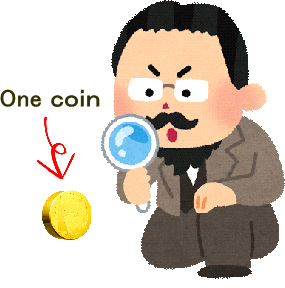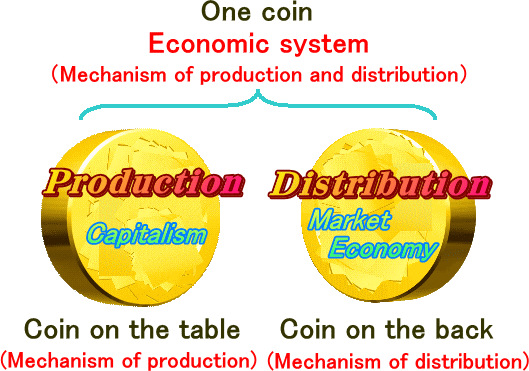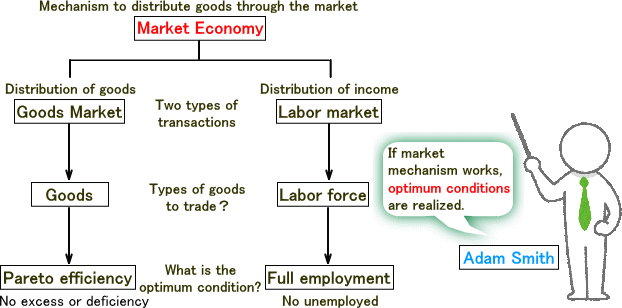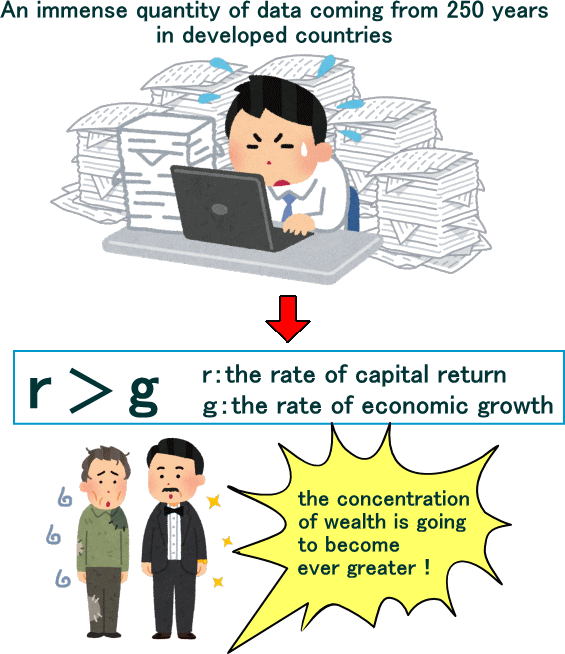
Special lecture Annotation of "Economics - by super time saving learning method"
Lecturer by Hidetsugu Arima
Capitalism and Market economy
1.What is an economic system?
Economic system is the social framework that supports the lives of people.
The economic system has two functions of production and distribution.
The mechanism of production is a mechanism to solve the problem "for whom, what kind of products, how, and who could produce?".
On the other hand, the mechanism of distribution is a mechanism whereby consumers (households) receive distribution of goods through trading in markets where products (goods and labor) are freely traded.
2.Capitalism ≠ market economy ?!
Let's take a look at a coin.

The front face on the coin = Capitalism (mechanism of production)
From the viewpoint of the mechanism of the production, capitalism can be regarded as an economic system that produces and supplies goods and services that meet the needs of society by capitalists (companies) who own production means (resources, production technology, labor).
The capitalists (private sector) are responsible for production activities with the aim of business (obtaining profit).
The back face on the coin = Market economy (mechanism of distribution)
From the viewpoint of the mechanism of distribution, the market economy can be regarded as an economic system by which goods and incomes are distributed through the market.
One coin = Economic system (mechanism of production and distribution)
In the short-time learning method of this website, Capitalism and Market economy are explained as the same economic system.
Here we assume that the two functions of the economic system ("mechanism of production" and "mechanism of distribution") are closely linked.
When assuming the economic system as a single coin, it is stamped the picture of Capitalism on the front side and the picture of the Market economy on the back side.Capitalism stands for the "mechanism of production" and the market economy stands for the "distribution mechanism".

In short, "to regard capitalism and market economy as one economic system"means that one coin, including the back and the table, is considered "one." This is a simple way of thinking based on Time-savings' learning method.

Capitalism≠market economy(Difference between Capitalism and Market economy)
On the other hand, there is the idea that capitalism and market economy are regarded as different economic systems.
This is a standpoint that sees the 'mechanism of production' and 'mechanism of distribution' in the economic system as separate and independent.
Capitalism is the mechanism by which capitalists using their own private property produces goods and supplies them to their society.
Capitalism emphasizes the mechanism of production and explains the economic system.
Market economy (goods market + labor market)
The market economy is explained by two types of transactions: the goods market that distributes goods and the labor market that distributes incomes.
The goods market is a place where you buy and sell goods (goods called final products).
The role of the goods market is to deliver the product from the producer (company) to the consumer (household).
In the goods market, we regard the state where goods are distributed without excess or shortage (neither unsold nor shortage of product) as optimum condition. This is called Pareto efficiency.
On the other hand, Labor market is a place where you buy and sell services called labor force(working force).
In the market, due to the operation of market mechanism (price mechanism), the supply and demand match and the transactions are established.
In the market, due to the operation of market mechanism (price mechanism), the supply and demand match and the transactions are established.
Adam Smith argued that the optimum state would be realized that the market mechanism works so that there is no shortage and unsold of goods as well as no unemployment.

3.Problems of Capitalism (What are the problems with capitalism?)
Let's mention the problems of Capitalism here.
The problem of capitalism lies in the behavior of capitalists.
Capitalists try to pursue their own interests.
First, capitalists try to dominate the goods market.
When the goods market is monopolized by a company, the mechanism of price adjustment by free competition does not work, so optimal resource allocation is not done.
Second, capitalists are to try to lower the wages of workers. In the labor market, the optimal distribution will not be made.
In addition, capitalists can live a luxurious life simply by investing private property, but workers can live only by selling their labor force.
The income disparity between capitalists and workers makes the society feel unequal.
There is concern that the dissatisfaction for the capitalism would expand.
Marx and Piketty: Critique on Capitalism
Karl Marx argued in his book "Das Kapital" (1867) that Capitalists should exploit workers, resulting in widening disparity and eventually capitalism should collapse.
Meanwhile, Thomas Piketty investigated and analyzed the relationship between income and wealth in the "Capital in the 21st century" (2013), using the tax records of the past 250 years in the Western developed countries.
He found a historical economic trend of "r> g" (r is the rate of return to wealth, g is economic growth rate). This means that wealth grows faster than economic outcomes.
He concludes that "the disparity in income distribution is expanding and that trend will continue in the future".

On the other hand, Piketty does not deny capitalism, but shows there needs to be more global cooperation that it is possible to rectify the disparity problem by sharing "information on cross-border financial assets" among governments around the world and conducting "A global wealth tax(a progressive global tax on wealth)".
Reference
参考 : Investopedia
What is the difference between a capitalist system and a free market system?
By Steven Nickolas | April 22, 2015 — 1:11 PM EDT
A capitalist system and a free market system are economic environments where supply and demand are the main factors of price and production of goods and services. Although the two economic systems are based on the law of supply and demand, these systems are different.
Capitalism is an economic system based on ownership of the factors of production. Some key features of capitalism are competition between companies and owners, private ownership and motivation to generate a profit. The production and pricing of goods and services is determined by the free market, or the supply and demand.
A free market system is an economic system based solely on demand and supply, and there is little or no government regulation. In a free market system, a buyer and a seller transact freely only when they voluntarily agree on the price of a good or a service. For example, suppose a seller wants to sell atoy for $5 and a buyer wants to buy that toy for $3. A transaction will occurwhen the buyer and the seller agree on a price.
Capitalism is focused on the creation of wealth and ownership of capital and factors of production, whereas a free market system is focused on the exchange of wealth, or goods and services. A free market system is based solely on supply and demand and leads to free competition in the economy, without any intervention from outside forces. On the other hand, a private owner in a capitalist system can have a monopoly on the market and prevent free competition.
 参考 : 特別講座 『超時短 一人で学べる・経済学』の注釈(Japanese ver.)
参考 : 特別講座 『超時短 一人で学べる・経済学』の注釈(Japanese ver.)
